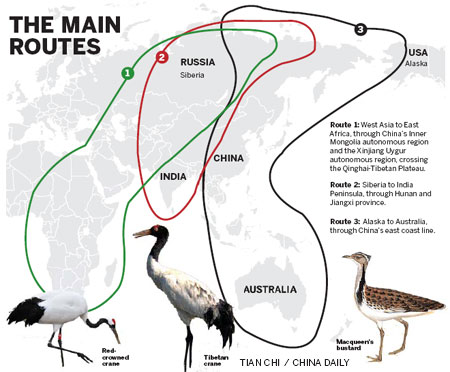Death flight for birds
Updated: 2012-11-01 08:09
By Yang Wanli (China Daily)
|
||||||||
Migration-route ambush provides rich pickings, reports Yang Wanli in Hunan province.
On an early October morning in the Luoxiao Mountains of Central China's Hunan province, the world was barely awake as Li Feng made his way through the clinging mists that blanketed the slopes and headed for the summit, a camera hidden in his pocket.
The surrounding area is pitted with hundreds of small caves, their entrances camouflaged by pine branches. The caves offer shelter to local hunters and Li, a photographer at a local newspaper and a volunteer for an NGO, the Hunan Bird Protection Camp, is taking a risk as he attempts to record their illegal activity. The hunters have a reputation for taking matters into their own hands when dealing with intruders.

Having reached the hilltop and taken photos of the scenery and the few birds in sight, Li hid his camera and, looking like any other fell walker taking a stroll, waited for sundown.
Fast-forward several hours: Shortly after nightfall, dozens of bright white spotlights were turned on simultaneously.
The lights attract the birds and soon the air is filled with the percussion of thousands of beating wings. The birds - including red-crowned cranes, Tibetan cranes, spot-billed ducks, greenwing and great egrets - from North China and even Siberia, are undertaking their twice-yearly migration to the warmer climes.
As they flew into range the guns fired. Continuously. The lights confuse the birds and encourage them to fly at lower altitudes, making them easy targets for the hunters. Those unscathed by the gunfire often end up entangled in the nets the hunters set up across the mountaintops. Escape is impossible.
Internet movie
At 11:30 on a Friday morning, Li was still in bed. During the past few days, he had been inundated with requests for interviews from newspapers, radio and television programs and he was exhausted.
"The State Forestry Administration is investigating the issue, and we want to hear a result before taking any further action," he said, his voice sounding sleepy on the other end of the phone.
Li's NGO sponsored a four-day trip to Hunan's rural areas, starting on Oct 26, to advocate greater protection for wild birds. Li's involvement was crucial - his reputation had been enhanced by a movie he made and posted on the Internet in September. The film, A Massacre on the Millennium Bird Trail, catapulted Li from local photographer to a national name, as it revealed the gruesome reality behind the slaughter of thousands of birds during the migration seasons in some parts of the province.
The 12-minute documentary has attracted attention from both environmentalists and the general public, and so far almost 430,000 people across China have watched the movie.
The film and local reports of the slaughter prompted Hunan's forestry authorities to launch a monthlong crackdown on illegal bird hunts. By Oct 25, 133 people had been detained on suspicion of participating in illegal bird hunts during the past five years.
Hu Changqing, deputy head of the Hunan Provincial Forestry Department, said that 92 cases have already been dealt with, and more than 115,000 captured birds had been released into the wild.
The State Forestry Administration issued an emergency nationwide ban on the hunting of migratory birds and other wildlife on Oct 24. It urged local forestry officials and police to strengthen law enforcement to protect wildlife and take greater precautions against poaching and the destruction of habitats. The authorities will also inspect markets, restaurants and hotels to ensure they are not engaged in the sale or consumption of migratory species.

 Relief reaches isolated village
Relief reaches isolated village
 Rainfall poses new threats to quake-hit region
Rainfall poses new threats to quake-hit region
 Funerals begin for Boston bombing victims
Funerals begin for Boston bombing victims
 Quake takeaway from China's Air Force
Quake takeaway from China's Air Force
 Obama celebrates young inventors at science fair
Obama celebrates young inventors at science fair
 Earth Day marked around the world
Earth Day marked around the world
 Volunteer team helping students find sense of normalcy
Volunteer team helping students find sense of normalcy
 Ethnic groups quick to join rescue efforts
Ethnic groups quick to join rescue efforts
Most Viewed
Editor's Picks

|

|

|

|

|

|
Today's Top News
Health new priority for quake zone
Xi meets US top military officer
Japan's boats driven out of Diaoyu
China mulls online shopping legislation
Bird flu death toll rises to 22
Putin appoints new ambassador to China
Japanese ships blocked from Diaoyu Islands
Inspired by Guan, more Chinese pick up golf
US Weekly

|

|






